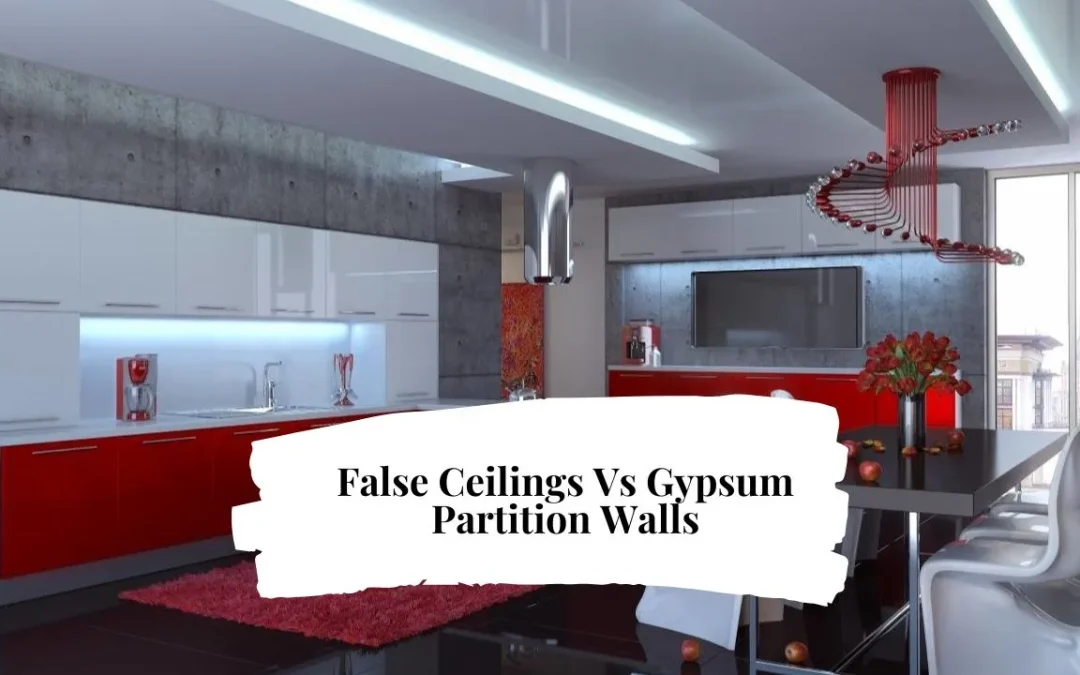Both false ceilings and gypsum partition walls come from the same idea, i.e., redefining how spaces look and function. But their role, placement, and purpose are entirely different. That’s where today’s comparison comes in handy at Gypsum Partition Dubai.
Understanding The Role, Placement, & Purpose of Gypsum Partition & False Ceilings
When you hear the words gypsum partition and false ceilings, the first thought is aren’t they exactly the same things? And, that’s the confusion we’ve cleared with a brief yet thorough understanding of these two terms.
What is Gypsum Partition?

Gypsum partition is a space-dividing partition system made of gypsum drywalls with metallic frames or wooden frames.
What is A False Ceiling?
Just as the name indicates, it’s a secondary ceiling created using different materials such as wood, plaster of Paris (POP), wood, metal, PVC, gypsum, etc for aesthetics, insulation, and other benefits.
1. Structural Placement & Functionality
Let’s start with where they go. False ceilings hang down from the main ceiling. They cover wiring, lighting, and ductwork. Their role is mostly above. In contrast, gypsum partition walls divide space. They create new zones, such as a dressing room from a bedroom or a meeting space in an office. That’s the basic difference.
Ceiling solutions refine overhead spaces while partition walls reshape ground layout. One handles what you see when you look up. The other shifts what’s around you. Both are installed with metal or aluminum frames and gypsum boards but the purpose defines their placement, not the material.
2. Visual Impact on Room Dimensions
A false ceiling lowers your vertical space but can make it feel more styled. You’ll often see them in rooms that feel too tall or echoey. They make ceiling lights more elegant and interiors more proportioned. On the flip side, gypsum partitions change the horizontal experience.
They can make a large room feel cozier, more private, or more defined. A long corridor or a big hall? You can break interiors with a partition. So while ceilings bring a space together vertically, partitions manage flow and function at ground level.
3. Lighting & Design Integration

Lighting fits naturally into false ceilings. It can be recessed lights, LED strips, backlighting, etc. All the options become easier and cleaner with a ceiling grid. It’s not just about hiding wires. It’s about the mood and symmetry of the interior and more you can say about the ambiance. That’s where ceiling systems have the edge.
Partition walls don’t offer light integration in the same way. But they do allow surface styling like textured paint, wallpaper, or inset shelving. That makes them useful for visual breaks in lounges, lobbies, or even open kitchens.
4. Flexibility & Future Change
False ceilings are more permanent once installed and altering their height or layout later can be costly and messy. Gypsum partitions, on the other hand, are easier to shift or remove. When you need a larger room, you can take one down and vice versa.
That flexibility makes partitions more suitable for changing layouts. Especially in rental offices or commercial setups where space is always evolving. False ceilings are a bigger commitment. But if the space needs lighting structure or insulation control, they’re worth it. It all comes down to how fixed or fluid your design needs to be.
5. Sound & Thermal Insulation
Both systems help reduce sound transfer but they do it differently. False ceilings create a buffer zone between levels. That helps reduce upstairs noise. They also block heat from roofs or upper floors, keeping the room cooler.
Partition walls block noise between rooms. They have insulation sheets inside and the soundproofing improves. So, the difference lies in direction. The choice depends on which direction the noise or temperature needs control.
6. Cost Comparison & Installation Efficacy
False ceilings tend to be slightly more expensive. They require precise framework, alignment, and finish, especially when lighting is involved. Partition walls usually cost less per square foot. The installation is faster and less messy. Worldwide, most fit-outs involving false ceilings are priced based on lighting zones and materials used.
Partition wall costs depend on thickness, insulation, and surface finish. For large-scale projects, combining both can raise total cost but also deliver better space use. That’s why many designers plan ceilings and partitions together to keep the budget practical and outcome unified.
7. Customization & Material Options

False ceilings come in different types such as gypsum, POP, wooden panels, or metal grids. Each has its own vibe. You can even mix materials for feature ceilings.
Partition walls, though, mostly use gypsum. But customization comes through how they’re finished. Wallpaper, texture paint, moldings, shelving, etc, and each one can be added to fit a style.
Read more: Gypsum Partition? Benefits, Uses & Types
Conclusion
False ceilings and gypsum partition walls do different things. But they share a common goal and make your space more usable, styled, and personalized. Just as ceilings shape the height, partitions shape the plan. It’s not about choosing one. It’s about knowing what each one does best, and then fitting it where it belongs. And when they work together, your home or office starts feeling complete not just covered. They can completely transform your interiors into modern outlooks with numerous practical benefits.

